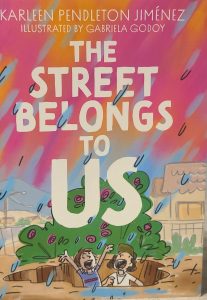Teaching kids to see themselves in their environment is crucial for holistic development. Author, Karleen Pendleton-Jimenez takes readers on a journey of the importance of this (the environment, self-awareness, and community) in her book, ‘The Streets Belongs to Us.’
“I don’t recognize our street anymore. It’s turned into a big mess of piles of brown dirt and deep holes. It’s like a garden right before you plant the seeds. Everything is torn up and ready for new life to grow. It’s the summer of 1984 in Los Angeles. Twelve-year-old Alex Richardson-Salazar is a mixed-race, Mexican American tomboy who would rather wear her hair short and her older brother’s hand-me-downs. And Wolf is a troubled kid who’s been wearing the same soldier’s uniform since his mom died. But when the city’s digging machines tear up their street to build sidewalks, the best friends seize the opportunity to turn Muscatel Avenue into a muddy wonderland” (Pendleton-Jimenez, 2021).
Navigating difficult and exciting changes is essential to a child’s growth and development. These experiences help children develop important life skills, build resilience, and learn how to adapt to new situations. As educators, we have unique gifts, tools, and resources to guide and encourage students in this meaningful development.
When kids are able to see themselves in their environment, it helps them develop a sense of self-identity and self-awareness. They begin to understand who they are, what makes them unique, and how they fit into the world around them. This self-identity and self-awareness are fundamental aspects of healthy psychological development and can contribute to positive self-esteem and confidence.
How is this evident in this book? Encouraging kids to see themselves in their environment promotes cultural and social awareness. It helps them understand their culture, heritage, and background and appreciate and respect the diversity of cultures and communities around them. This can foster empathy, tolerance, and inclusivity and contribute to the development of socially responsible individuals who can thrive in a multicultural world.
By seeing themselves in their environment (being a part of their environment), kids can develop a connection and appreciation for the natural world. They can learn to value and respect nature, understand their role in protecting the environment, and develop a sense of environmental consciousness. This can foster a sense of stewardship towards the planet, leading to responsible environmental behaviours and actions.
When kids learn to see themselves in their environment, they develop critical thinking and problem-solving skills. They learn to observe, analyze, and interpret their surroundings, which promotes cognitive development and nurtures their ability to think critically and solve problems. This skill can benefit them in various aspects of life, from academics to personal and professional relationships.
Emotional and Mental Well-Being is developed richly and deeply rooted when children see themselves and can be themselves in their environment. It helps them develop a sense of belonging and connectedness, which is crucial for healthy emotional development. When kids feel like they belong in their environment, they are more likely to have positive emotional experiences, develop resilience, and have better mental health outcomes.
Teaching kids to see themselves in their environment is vital for their overall development, including self-identity, cultural and social awareness, environmental consciousness, critical thinking and problem-solving skills, and emotional and mental well-being. It nurtures their sense of self and connection with the world around them, preparing them to thrive as responsible and engaged individuals in their communities and beyond.
Karleen invites us as educators to explore what our classrooms and communities could sound like, look like, and feel like when we foster spaces for students to see (inquire) and to be seen (explore). Or, as she said in her own words, “Bursting with life and feeling, both the people and the land come alive… The Street Belongs to Us is a story of family, friendship, and unconditional acceptance, even when it breaks your heart.” (Pendleton-Jimenez, 2021).
References:
Pendleton-Jimenez, K. (2021). The Streets Belong to Us. Vancouver, BC: Arsenal Pulp Press.

